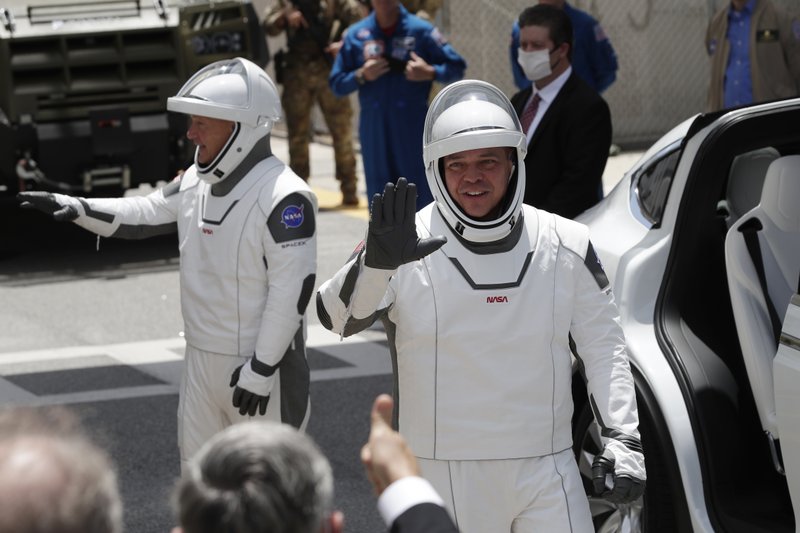A rocket ship designed and built by Elon Musk’s SpaceX company has lifted off with two Americans on a history-making flight to the International Space Station.
The spacecraft took off Saturday afternoon from the same launch pad at Cape Canaveral, Florida, that was used during the Apollo missions to the moon a half-century ago.
The flight ushers in a new era in commercial space travel and marks the first time NASA has launched astronauts from U.S. soil in nearly a decade.
“Let’s light this candle,” commander Doug Hurley said just before liftoff.
[Video not showing up above? Click here to watch » https://www.youtube.com/watch?v=bIZsnKGV8TE]
Ever since the space shuttle was retired in 2011, NASA has relied on Russian rockets launched from Kazakhstan to take U.S. astronauts took and from the space station.
EARLIER
CAPE CANAVERAL, Fla. — Two NASA astronauts climbed into their capsule Saturday for a second attempt at a history-making ride into orbit aboard a rocket ship designed and built by Elon Musk's SpaceX company.
Stormy weather had threatened another postponement most of the day, but the outlook improved markedly in the afternoon, just ahead of the scheduled 3:22 p.m. liftoff of the 270-foot Falcon 9 in what would be the first launch of astronauts into orbit by a private company.
Their destination: the International Space Station, 250 miles above Earth.
It would also be NASA’s first human spaceflight launched from U.S. soil in nearly a decade.
The mission unfolded amid the gloom of the coronavirus outbreak, which has killed over 100,000 Americans, and racial unrest across the U.S. over the death of George Floyd, a handcuffed black man, at the hands of Minneapolis police. NASA officials and others held out hope the flight would would lift American spirits.
“Maybe there’s an opportunity here for America to maybe pause and look up and see a bright, shining moment of hope at what the future looks like, that the United States of America can do extraordinary things even in difficult times,” NASA Administrator Jim Bridenstine said.
Veteran astronauts Doug Hurley and Bob Behnken pulled on their angular, white-and-black spacesuits with help from technicians wearing masks, gloves and black hoods that made them look like ninjas.
Before setting out for the launch pad in a gull-wing Tesla SUV — another Musk product — Behnken pantomimed a hug of his 6-year-old son, Theo, and said: “Are you going to listen to Mommy and make her life easy?” Hurley blew kisses to his 10-year-old son and wife.
SpaceX and NASA monitored the weather not just at Kennedy Space Center, where rain, thick clouds and the chance of lightning threatened another postponement, but all the way up the Eastern Seaboard and across the North Atlantic to Ireland. Waves and wind need to be within certain limits in case the astronauts have to make an emergency splashdown on the way to orbit.
Wednesday’s countdown of the rocket and its bullet-shaped Dragon capsule was halted at just under 17 minutes because of the threat of lightning.
Ever since the space shuttle was retired in 2011, NASA has relied on Russian spaceships launched from Kazakhstan to take U.S. astronauts to and from the space station.
“I would be lying to you if I told you I wasn’t nervous,” Bridenstine said before the launch attempt. “We want to do everything we can to minimize the risk, minimize the uncertainty, so that Bob and Doug will be safe.”
President Donald Trump and Vice President Mike Pence planned to return for the second launch attempt.
Because of the coronavirus, NASA severely limited the number of employees, visitors and journalists allowed deep inside Kennedy Space Center, and the crowd was relatively small, at a few thousand. At the center's tourist complex, though, all 4,000 tickets were snapped up in a few hours.
The space agency urged people to stay safe and watch from home, and by NASA's count, at least 1.14 million viewers followed the launch preparation online. But spectators also began lining the Cape Canaveral area’s beaches and roads. Signs along the main beach drag read, “Godspeed.”
Among the spectators was Neil Wight, a machinist from Buffalo, New York, who staked out a view of the launch pad from a park in Titusville.
“It’s pretty historically significant in my book and a lot of other people’s books. With everything that’s going on in this country right now, it’s important that we do things extraordinary in life,” Wight said. “We’ve been bombarded with doom and gloom for the last six, eight weeks, whatever it is, and this is awesome. It brings a lot of people together.”
NASA hired SpaceX and Boeing in 2014 to taxi astronauts to and from the space station, under contracts totaling $7 billion. Both companies launched their crew capsules last year with test dummies. SpaceX’s Dragon aced all of its objectives, while Boeing’s Starliner capsule ended up in the wrong orbit and was almost destroyed because of software errors.
As a result, the first Starliner flight carrying astronauts isn’t expected until next year.
